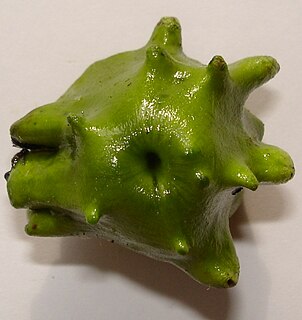
Galls or cecidia are a kind of swelling growth on the external tissues of plants, fungi, or animals. Plant galls are abnormal outgrowths of plant tissues, similar to benign tumors or warts in animals. They can be caused by various parasites, from viruses, fungi and bacteria, to other plants, insects and mites. Plant galls are often highly organized structures so that the cause of the gall can often be determined without the actual agent being identified. This applies particularly to some insect and mite plant galls. The study of plant galls is known as cecidology.

Gall wasps, also called gallflies, are a family (Cynipidae) in the wasp superfamily Cynipoidea within the suborder Apocrita of the order Hymenoptera. Their common name comes from the galls they induce on plants for larval development. About 1300 species of this generally very small creature (1–8 mm) are known worldwide, with about 360 species of 36 different genera in Europe and some 800 species in North America.

Andricus quercuscalicis is a gall wasp species inducing knopper galls.

Andricus kollari is species of wasp which causes the formation of marble galls on oak trees.

Andricus foecundatrix is a parthenogenetic gall wasp which lays a single egg within a leaf bud, using its ovipositor, to produce a gall known as an oak artichoke gall, oak hop gall, larch-cone gall or hop strobile The gall develops as a chemically induced distortion of leaf axillary or terminal buds on pedunculate oak or sessile oak trees. The larva lives inside a smaller hard casing inside the artichoke and this is released in autumn. The asexual wasp emerges in spring and lays her eggs in the oak catkins. These develop into small oval galls which produce the sexual generation of wasps. A yew artichoke gall caused by the fly Taxomyia taxi also exists, but is unrelated to the oak-borne species. Previous names or synonyms for the species A. fecundator are A. fecundatrix, A. pilosus, A. foecundatrix, A. gemmarum, A. gemmae, A. gemmaequercus, A. gemmaecinaraeformis and A. quercusgemmae.

Cola-nut galls develop as a chemically induced distortion of leaf axillary or terminal buds on pedunculate oak or sessile oak trees, caused by the agamic gall wasp Andricus lignicola which lays single eggs within leaf buds using their ovipositor. A previous name or synonym for the species A. lignicola is A. lignicolus and A. venheurni.

Andricus is a genus of gall wasps in the family Cynipidae, comprising the following species:

Andricus grossulariae is a gall wasp species inducing agamic acorn cup galls on oak tree acorn cups and sexual phase galls on catkins. Synonyms include Andricus fructuum, Andricus gemellus, Andricus intermedius, Andricus mayri and Cynips panteli.

Pammene amygdalana is a species of moth of the family Tortricidae. It is found from Belgium and Germany to the Iberian Peninsula, Italy, Austria and Hungary and from France to Romania and Bulgaria.

Andricus dentimitratus is a gall forming wasp in the genus Andricus. The adults lay their eggs on various species of oak and the developing larvae causes the trees to create a large ornate gall. The oaks parasitised include Quercus frainetto, Q. petraea, Q. pyrenaica, Q. pubescens and Q. robur. The gall is formed out of the cup of the acorn. In cross-section it resembles a mushroom. It is woody, maroon, shiny and sticky. It grows up to 25 mm high and 20 mm wide. What resembles the head of the mushroom is lobed or toothed in various ways. The insect emerges from the narrowing, between the head and base.

Adelaide Local Nature Reserve is in North West London, in the area of Chalk Farm, Primrose Hill, Belsize Park and Swiss Cottage. It is managed by a local volunteer group, the Adelaide Nature Reserve Association, which works with the council to improve the site for wildlife and local community use and enjoyment. The site is a Local Nature Reserve and Site of Borough Importance for Nature Conservation, Grade 1.

Andricus aries is a species of gall-forming wasps, in the genus Andricus. The species was named by the French entomologist Joseph-Étienne Giraud, in 1859. It is commonly found in eastern Europe and during the 21st century has spread to western Europe.
The Enescu Prize is a prize in music composition founded by the Romanian composer George Enescu, awarded from 1913 to 1946, and afterwards by the National University of Music Bucharest. Enescu is regarded by many as Romania's most important musician. Winners include Mihail Andricu and Sergiu Natra.
Andricus opertus, the fimbriate gall wasp, is a species of wasp in the family Cynipidae whose bisexual generation induces elongate, spiky galls on the leaves of various species of oaks in California, including valley oak and scrub oak. The galls of the bisexual generation form in spring, adults emerge in late spring, and galls persist on trees until the fall. The unisexual generation of this species forms aborted bud galls in the summer and fall.
Andricus quercusfoliatus, the leafy oak gall wasp, is a species of gall wasp in the family Cynipidae.

Andricus kingi, the red cone gall wasp, is a species of gall wasp in the family Cynipidae.
Andricus corruptrix is a species of gall-forming wasp, in the genus Andricus. It is found in Europe.
Andricus inflator is a species of gall-forming wasps, in the genus Andricus. The species was named by the German biologist Theodor Hartig, in 1840 and is found in Europe.
Andricus infectorius is a species of gall-forming wasp. The species was named by the German biologist Theodor Hartig, in 1843 and is found in Europe.












